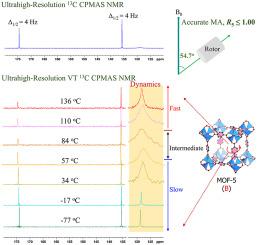Solid-state NMR spectroscopy at ultrahigh resolution for structural and dynamical studies of MOFs
Abstract
To characterize the structure and dynamics of metal–-organic frameworks (MOFs) in-depth at the molecular level, it is necessary to pursue high-resolution solid-state magic angle spinning (MAS) nuclear magnetic resonance (NMR) spectroscopy. Spectral resolution is usually affected by the quality of materials and various experimental conditions, of which magic angle (MA) accuracy is a crucial determinant. The current industrial criteria for MA calibration based on the common standard of KBr were found insufficient in guaranteeing optimal resolution MAS NMR for highly ordered MOFs. To drive towards higher-resolution MAS NMR spectroscopy, we propose a calibration protocol for more accurate MA with a higher-precision criterion based on 79Br MAS NMR of KBr, where the linewidth ratio of the fifth-order spinning sideband to the central band of KBr should be less than 1.00. As a result, ultrahigh-resolution 13C cross-polarization (CP) MAS NMR of MOF-5 is achieved with minimal linewidths as low as 4 Hz, and therefore MOF-5 can be used as a new standard convenient for verifying MA accuracy and also optimizing 13C CP conditions. Maintaining high-precision MA under variable temperature (VT) was found challenging on certain commercial MAS NMR probes, as was systematically investigated by VT NMR using KBr and MOF-5. Nevertheless, ultrahigh-resolution MAS NMR spectroscopy with stable MA under VT is employed to reveal fine structures and linker dynamics of a series of Zn-based MOFs with highly regulated structures. The ultrahigh-resolution NMR methodcan be generally applied to study a broad range of MOFs and other materials.


 求助内容:
求助内容: 应助结果提醒方式:
应助结果提醒方式:


